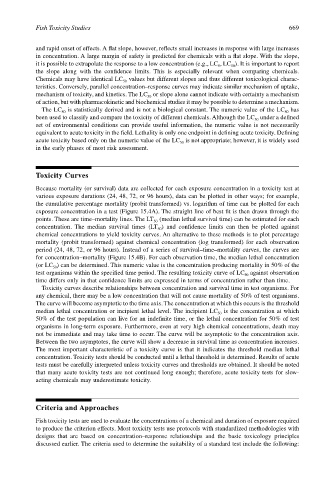Page 689 - The Toxicology of Fishes
P. 689
Fish Toxicity Studies 669
and rapid onset of effects. A flat slope, however, reflects small increases in response with large increases
in concentration. A large margin of safety is predicted for chemicals with a flat slope. With the slope,
it is possible to extrapolate the response to a low concentration (e.g., LC , LC ). It is important to report
10
5
the slope along with the confidence limits. This is especially relevant when comparing chemicals.
Chemicals may have identical LC values but different slopes and thus different toxicological charac-
50
teristics. Conversely, parallel concentration–response curves may indicate similar mechanism of uptake,
mechanism of toxicity, and kinetics. The LC or slope alone cannot indicate with certainty a mechanism
50
of action, but with pharmacokinetic and biochemical studies it may be possible to determine a mechanism.
The LC is statistically derived and is not a biological constant. The numeric value of the LC has
50
50
been used to classify and compare the toxicity of different chemicals. Although the LC under a defined
50
set of environmental conditions can provide useful information, the numeric value is not necessarily
equivalent to acute toxicity in the field. Lethality is only one endpoint in defining acute toxicity. Defining
acute toxicity based only on the numeric value of the LC is not appropriate; however, it is widely used
50
in the early phases of most risk assessment.
Toxicity Curves
Because mortality (or survival) data are collected for each exposure concentration in a toxicity test at
various exposure durations (24, 48, 72, or 96 hours), data can be plotted in other ways; for example,
the cumulative percentage mortality (probit transformed) vs. logarithm of time can be plotted for each
exposure concentration in a test (Figure 15.4A). The straight line of best fit is then drawn through the
points. These are time–mortality lines. The LT (median lethal survival time) can be estimated for each
50
concentration. The median survival times (LT ) and confidence limits can then be plotted against
50
chemical concentrations to yield toxicity curves. An alternative to these methods is to plot percentage
mortality (probit transformed) against chemical concentration (log transformed) for each observation
period (24, 48, 72, or 96 hours). Instead of a series of survival–time–mortality curves, the curves are
for concentration–mortality (Figure 15.4B). For each observation time, the median lethal concentration
(or LC ) can be determined. This numeric value is the concentration producing mortality in 50% of the
50
test organisms within the specified time period. The resulting toxicity curve of LC against observation
50
time differs only in that confidence limits are expressed in terms of concentration rather than time.
Toxicity curves describe relationships between concentration and survival time in test organisms. For
any chemical, there may be a low concentration that will not cause mortality of 50% of test organisms.
The curve will become asymptotic to the time axis. The concentration at which this occurs is the threshold
median lethal concentration or incipient lethal level. The incipient LC is the concentration at which
50
50% of the test population can live for an indefinite time, or the lethal concentration for 50% of test
organisms in long-term exposure. Furthermore, even at very high chemical concentrations, death may
not be immediate and may take time to occur. The curve will be asymptotic to the concentration axis.
Between the two asymptotes, the curve will show a decrease in survival time as concentration increases.
The most important characteristic of a toxicity curve is that it indicates the threshold median lethal
concentration. Toxicity tests should be conducted until a lethal threshold is determined. Results of acute
tests must be carefully interpreted unless toxicity curves and thresholds are obtained. It should be noted
that many acute toxicity tests are not continued long enough; therefore, acute toxicity tests for slow-
acting chemicals may underestimate toxicity.
Criteria and Approaches
Fish toxicity tests are used to evaluate the concentrations of a chemical and duration of exposure required
to produce the criterion effects. Most toxicity tests use protocols with standardized methodologies with
designs that are based on concentration–response relationships and the basic toxicology principles
discussed earlier. The criteria used to determine the suitability of a standard test include the following:

